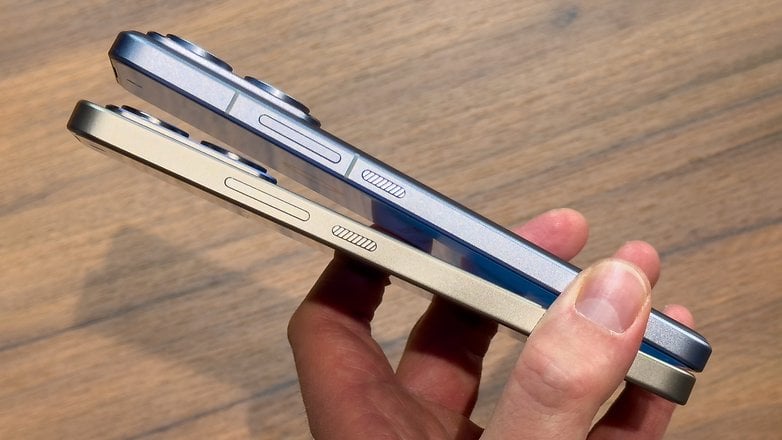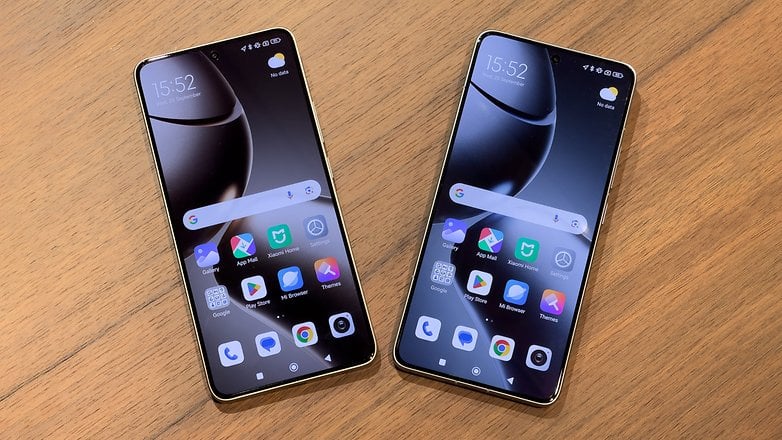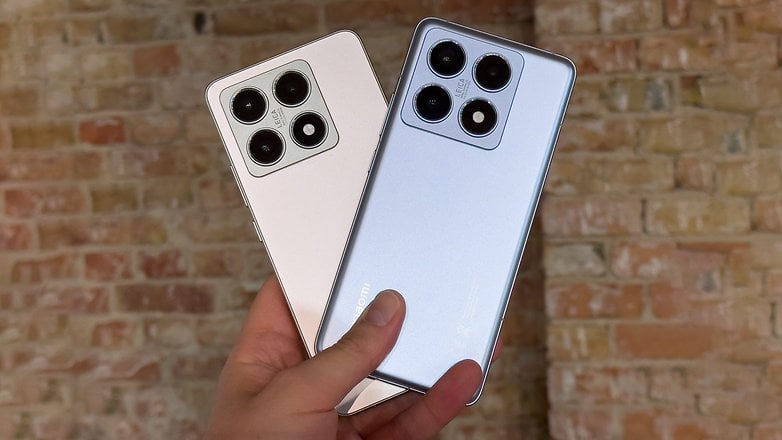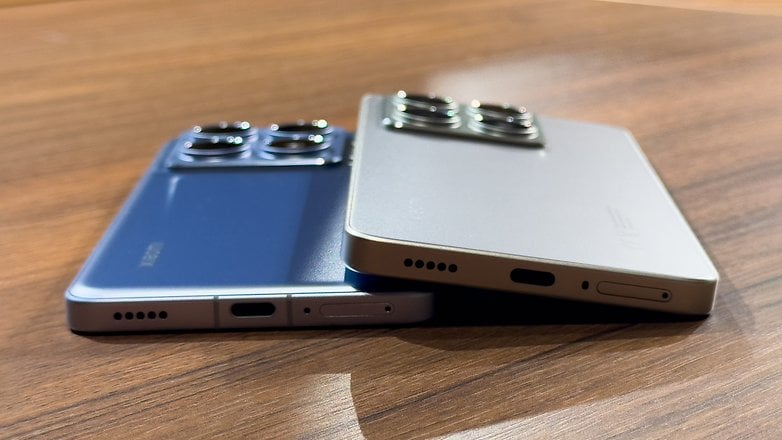
We got to know the global Xiaomi 14 series back in spring, with both the Xiaomi 14 (review) and the powerful Xiaomi 14 Ultra (review) making it to Europe. Now the smartphone giant is stepping up its game and offering us two more models, the Xiaomi 14T and the 6.67-inch Xiaomi 14T Pro, which should offer you similar flagship qualities at a lower price.
Xiaomi 14T Pro and Xiaomi 14T head-to-head
| Pro model | Base model | |
|---|---|---|
| Product | ||
| Picture |  |
 |
| Review |
Xiaomi 14T Pro Review |
|
| Display |
|
|
| SoC |
|
|
| Memory |
|
|
| OS |
|
|
| Camera |
|
|
| Selfie Camera | ||
| Battery |
|
|
| Connectivity |
|
|
| IP Certification | ||
| Dimensions and weight |
|
|
| Offers* |
|
|
Price and availability
You can purchase the Xiaomi 14 and its Pro brother now and there are three colors to choose from: Titan Gray, Titan Blue and Titan Black. You can also choose between different memory configurations. The base model combines 12 GB of RAM with 256 or 512 GB of non-expandable storage and starts at just under 650 euros. The Xiaomi 14T Pro, which is available from 799 euros, comes with a variant with 1 TB of storage on top. Here is an overview of the variants:
| Xiaomi 14T Pro | Xiaomi 14T | |
|---|---|---|
| 256 GB | €800 (approx. $895) | €650 (~$725) |
| 512 GB | €900 (~$1000) | €700 (~$780) |
| 1 TB | €1000 (~$1120) | – |
The phones won’t be officially sold in the US, but may be offered by third-party marketplace sellers. In Europe, meanwhile, if you decide quickly, you can save a lot of money. Xiaomi is offering the very early birds a really nice decision-making aid in the form of discounts on its website! If you buy before October 11, you can get the Xiaomi 14T Pro (12 GB + 1 TB) for €899.90, which is €100 less. The Xiaomi 14T (12 GB + 512 GB) is on sale for 649.90 euros, which is also 50 euros cheaper.
Still not enough? Good, because Xiaomi has even more to offer for quick decision-makers: The Redmi Pad Pro (MSRP €300 euros) is also available free of charge, and if you spend an additional 0.99 euros, you can also bag yourself a charger. As mentioned, the charger is no longer automatically included in the box. But if you can get the 120 W charger for the Pro or the 67 W charger for the standard model for just under one euro, you’re unlikely to complain, right?
Design and display
Design
In contrast to last year, this year Xiaomi has decided to build both smartphones a similar size and to equip both with a 6.67-inch display. Accordingly, both models look very similar, both with a “Leica”-branded camera area on the back. The biggest visual difference is that while the Xiaomi 14T has smooth edges, the Xiaomi 14T Pro has rounded edges on all sides at the back. We can also see the antenna strips on the metal frame of the Pro, which we do not find on the standard model.

At 8.39 mm, the Pro is also slightly thicker than the Xiaomi 14T, which is 7.8 mm (glass) or 7.95 mm (polyurethane) thin, depending on the material. As expected, both models are IP68-certified and therefore water and dust resistant. As mentioned above, both phones are available in gray, blue and black.
Display

Xiaomi offers us a display resolution of 2,712 x 1,220 px, which corresponds to a pixel density of 446 ppi. The rest of the panels are also identical: both offer a peak brightness of 4,000 nits and repeat images at 144 Hz. The screen-to-body ratio is also identically high for both displays at 93.3 percent.
Standards such as Dolby Vision and HDR 10+ are of course supported, so we assume that our tests will confirm the flagship level of the displays for both models.
Performance and connectivity
We also recognize a familiar pattern in the choice of SoCs: As in the previous year, Xiaomi relies on the most powerful Snapdragon available for its traditional Xiaomi 14 models, while the “T” models are equipped with MediaTek chipsets. The Pro uses MediaTek’s top-of-the-line Dimensity 9300+ SoC, while the Dimensity 8300+ Ultra in the Xiaomi 14T has a little less steam under the kettle.
But honestly? You shouldn’t experience any performance problems with either model. Especially as Xiaomi is focusing heavily on AI and therefore has to rely on sufficiently high performance for this alone. Our tests, including benchmark comparisons, will soon provide you with clarity in this regard too.
Another thing we already know: Not all storage and RAM options make it onto the global smartphone. This means that with 12 GB of LPDDR5X RAM, we are offered a single option. The UFS 4.0 memory comes with 256 GB and 512 GB respectively, with the Pro also getting the additional 1 TB variant.
Very little has changed in terms of connectivity compared to last year’s models. However, this is due to the fact that the level was already high with the Xiaomi 13T devices. The Xiaomi 14T Pro therefore retains Wi-Fi 7, Bluetooth and eSIM support, while the Xiaomi 14T only lags slightly behind in terms of Wi-Fi (6E).
Camera
Both devices rely on a triple camera with the Leica label, consisting of a main camera with 50 MP, a 12 MP ultra-wide angle and a telephoto camera with 50 MP. Since the line-up looked exactly the same in terms of megapixels last year, a quick glance at the spec sheet might suggest that not much has changed since 2023.

On closer inspection, however, we can see the differences to last year and also between the two devices in the 14T series. The 50 MP main camera in the Pro comes with f/1.6 aperture and relies on the “Light Fusion 900” image sensor, which we know from the Xiaomi 14. The Xiaomi 14T relies on the Sony IMX906 image sensor with f/1.7 aperture and, just like the Pro, the latest Leica Summilux lens is installed. At the front we find a 32 MP shooter for your selfies.
As with other manufacturers, Xiaomi naturally relies heavily on artificial intelligence to tease out as much as possible from the images. To this end, Xiaomi is now relying on Xiaomi AISP, just like with the Xiaomi 14 Ultra. This platform for computer-aided photography is designed to optimize the dynamic range and reduce image noise. Among other things, Xiaomi wants to ensure better, more natural portrait shots, but above all take night photos with poor lighting conditions to a new level. So you can certainly look forward to our galleries, which we will update this article with soon.
Software: The big AI club
In terms of software, Xiaomi largely behaves in the same way as with its other flagship models in the Xiaomi 14 series. In other words, you get HyperOS based on Android 14 on both smartphones, plus five years of support for security updates and four years of Android updates. So far, so expected.
What is new, however, is what has happened when it comes to AI. Xiaomi benefits from the expired exclusivity that previously only allowed certain functions for selected Pixel and Galaxy smartphones. In other words: Say hello to Google Gemini on both new Xiaomi phones! The company wants to help you with productivity, smart travel and the uncomplicated creation of content through AI.
In concrete terms, this means that in addition to Gemini, Circle to Search will also find its way onto Xiaomi 14T devices. The AI Interpreter helps with translations, AI Notes and the AI Recorder offer smart speech-to-text translations and text translations and summaries are also possible.
Creatives will be delighted with AI Image Editing, AI Eraser Pro (comparable to Magic Eraser), AI Film and AI Portrait to get all kinds of things out of your photos and videos. In our tests of these smartphones at the latest, we will be able to tell you how Xiaomi is now also leaving Apple behind when it comes to AI.
Battery: Xiaomi, where are the chargers?
When we talk about batteries and fast charging standards, we are clearly entering Xiaomi territory. The Chinese simply always deliver more here than Samsung and Apple. This also applies to the new T models, which each have batteries with a capacity of 5,000 mAh. The Xiaomi 14T Pro charges with a very fast 120 W, and even wirelessly, Xiaomi is faster than the latest iPhone 16 (test) with 50 W.

The basic model, on the other hand, is a little slower and offers us wired charging with 67 W and no wireless charging. So if you want to charge as quickly or as wirelessly as possible, it’s better to go for the Pro with these two alternatives.
Unfortunately, Xiaomi also makes us swallow a bitter pill: In contrast to the company’s previous behavior, this time you won’t see a charger when you unpack the device. Yes, Xiaomi also stopped to pack the charger in the phone box.
Conclusion
Xiaomi is not exactly turning its portfolio inside out with these two models, but it is at least offering a decent product update. We have yet to find out how significant the update is for the advertised night photography. The arrival of its own AI functions and Google tools such as Gemini and Circle to Search is probably the most striking new feature of the Xiaomi 14T Pro and Xiaomi 14T.
The camera line-up remains roughly the same, the quality of the displays is similar to last year’s and much of the battery also remains unchanged. Okay, with the latter we are happy about wireless charging with 50 W on the Pro—and annoyed about the lack of chargers in the box. We will comment on the skills of the cameras and the performance as well as the battery life when the tests are complete.
So far, we are left with two fine new smartphones that do not differ significantly from the previous year, apart from the AI. My tendency so far is therefore: If you own a model from the 13T series or even one from the Xiaomi 14 series, you don’t need to upgrade. But if you want to take advantage of the early bird offers quickly and are looking for a new smartphone anyway, you will be offered two very versatile smartphones. Keep in mind, however, that the powerful Xiaomi 14 Ultra sometimes is discounted to the same levels as the new top-spec 14T Pro!
Question for everyone: If you have your eye on one of the new models, would you prefer the Xiaomi 14T or the Xiaomi 14T Pro? And which new feature are you most excited about?






